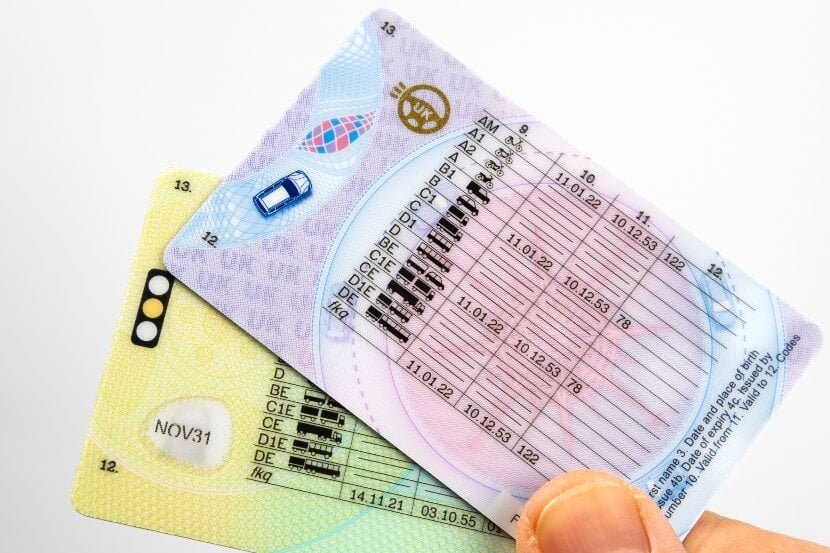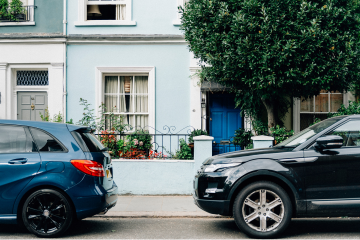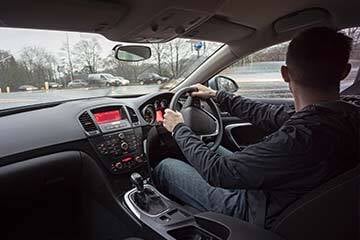What do those random numbers and letters on your DVLA driving licence mean?
Owning a car is hard enough - having to sort car insurance, tax and maintenance, without the extra headache of working out your licence entitlement.
So let's look at what all the codes and categories on your driving licence actually mean, and what you could be entitled to drive.

What are driving licence categories and codes?
It’s important that you know what you're allowed to drive, along with any restrictions you might have to follow.
This information is on your UK driving licence, whether that's a provisional or full licence, so check it if you’re not sure.
On the back of your driving licence, there are columns numbered between 9 and 12.
The column marked ‘9’ refers to the types of vehicles you can drive. Columns ‘10’ and ‘11’ list the start and expiry dates of your licence for the various categories of vehicle.
The column marked ‘12’ lists driving licence codes. Take a look at the full list of driving licence codes and what they mean.
Driving licence categories: what can I drive on a normal car licence?
You have an entitlement to drive certain vehicles as soon as you get a full driving licence.
Here's what they usually include.
| Category | Vehicle type | Additional driving test needed? | Definition |
|---|---|---|---|
|
A1
|
Motorbike
|
Yes
|
You can drive a light motorcycle with an engine of up to 125cc
|
|
AM
|
2 or 3-wheeled vehicles and light quad bikes
|
Yes
|
You can drive a 2 or 3-wheeled vehicle with a maximum speed of more than 15.5mph, but not more than 28mph. You also can ride a light quad bike with an unladen mass of not more than 350kg not including batteries.
|
|
B
|
Cars
|
No
|
Max 8 passenger seats
|
|
B auto
|
Automatic cars
|
No
|
You can only drive an automatic car
|
|
BE
|
Cars and trailers
|
No
|
You can drive a car or trailer of up to 3500kg in MAM
|
|
B1
|
4-wheeled vehicles
|
No
|
You can drive a light vehicle with up to 550kg if they're carrying goods
|
|
f
|
Agricultural tractor
|
No
|
You can drive a tractor
|
|
k
|
Mowing machine or pedestrian-controlled vehicle
|
No
|
You can drive a pedestrian-controlled vehicle or a mowing machine
|
|
q
|
2 or 3-wheeled vehicles
|
No
|
You can drive 2 or 3-wheeled vehicles without pedals and with an engine size of more than 50cc. The top speed can't be more than 15.5mph.
|
Category B - passed before 1 January 1997
You can drive a 4-wheel vehicle and trailer combination with a maximum authorised mass (MAM) of 8,250kg if you passed before 1 January 1997. You can also drive a minibus with a trailer over 750kg MAM.
Category B - passed after 1 January 1997
If you passed your driving test on or after January 1997 you can drive vehicles up to 3,500kg MAM, with up to 8 passenger seats, plus a trailer up to 750kg.
You can also tow heavier trailers if the vehicle and trailer MAM is not more than 3.500kg.
You're allowed to ride motor tricycles with a power output higher than 15kW, providing you’re over 21 years old.
If you have a physical disability with provisional category B entitlement, you also have provisional entitlement to ride Category A1 or A motor tricycles.
This isn’t the full list, especially if you passed your test before 1997. For further information about categories or if your licence includes other category entitlements, check out the government’s driving licence website.
Are there any other driving licence categories?
Once you’ve got a full driving licence, you might want to upgrade your entitlement so you can drive other vehicles for work or leisure.
For example, if you want to drive a bus, coach or lorry for a living, you need a Certificate of Professional Competence (CPC) to get a Category C entitlement.
Here are a few of the more common other categories you might need to take extra tests on to secure an additional entitlement.
| Category | Vehicle type | Additional driving test needed? | Definition |
|---|---|---|---|
|
C
|
Large vehicles
|
Yes
|
You can drive vehicles over 3500kg with a trailer up to 750kg MAM
|
|
CE
|
Large vehicles
|
Yes
|
You can drive category C vehicles with a trailer over 750kg
|
|
D1
|
Minibus
|
Yes
|
You can drive minibuses up to 8 metres long, no more than 16 passenger seats, plus a trailer of up to 750kg. D1E allows you to haul a trailer of more than 750kg.
|
|
h
|
Tracked vehicles
|
Yes
|
You can drive tracked vehicles including former military vehicles
|
|
l
|
Electrically-propelled vehicles
|
Yes
|
You can drive electrically-propelled vehicles
|
|
m
|
Trolley vehicles
|
Yes
|
You can drive trolley vehicles
|
Van driving licence categories
To drive larger vans, you’ll need one of the following categories:
- C1: You can drive vehicles weighing between 3,500kg and 7,500kg MAM (Maximum Authorised Mass) with a trailer weighing up to 750kg.
- C: You can drive vehicles weighing over 3,500kg MAM with a trailer weighing up to 750kg.
- CE: You can drive category C vehicles with a trailer weighing over 750kg.
Moped and motorcycle driving licence categories
To ride mopeds or motorcycles, you’ll need one of these categories:
- AM: You can ride 2- or 3-wheeled vehicles with a top speed between 15.5mph and 28mph. This includes light quad bikes weighing under 350kg (excluding batteries).
- A1: You can ride motorcycles up to 125cc with a maximum power output of 11kW and a power-to-weight ratio not exceeding 0.1kW/kg. You can also ride motor tricycles with power outputs up to 15kW.
- A2: You can ride motorcycles with a maximum power output of 35kW and a power-to-weight ratio not exceeding 0.2kW/kg.
Minibus driving licence categories
If you plan to drive a minibus, you’ll need one of the following categories:
- D1: You can drive minibuses with a maximum length of 8 metres and no more than 16 passenger seats. You can also tow a trailer weighing up to 750kg.
D1E: You can drive category D1 vehicles with a trailer weighing over 750kg.
What are driving licence codes?
Driving licence codes stipulate what conditions you must meet before you can get behind the wheel.
There are more than 50 driving licence codes. Some of the common ones include ‘01’, which relate to eyesight, and ‘02’, which is to do with hearing aids.
There are also codes that relate to vehicle modifications.
Full list of driving licence codes
| Driving licence code | Meaning |
|---|---|
|
01
|
Eyesight correction, e.g. glasses or contact lenses
|
|
02
|
Hearing/communication aid
|
|
10
|
Modified transmission
|
|
15
|
Modified clutch
|
|
20
|
Modified braking systems
|
|
25
|
Modified accelerator systems
|
|
30
|
Combined braking and accelerator systems (pre 28 November 2016)
|
|
31
|
Pedal adaptations and pedal safeguards
|
|
32
|
Combined service brake and accelerator systems
|
|
33
|
Combined service brake, accelerator and steering systems
|
|
35
|
Modified control layouts
|
|
40
|
Modified steering
|
|
42
|
Modified rear
|
|
43
|
Modified driving seats
|
|
44
|
Modifications to motorbikes
|
|
44 (1)
|
Single operated brake
|
|
44 (2)
|
Adapted front wheel brake
|
|
44 (3)
|
Adapted rear wheel brake
|
|
44 (4)
|
Adapted accelerator
|
|
44 (5)
|
(adjusted) manual transmission and manual clutch
|
|
44 (6)
|
(adjusted) rear
|
|
44 (7)
|
(adjusted) commands (direction indicators, braking light, etc)
|
|
44 (8)
|
Adjusted seat height allowing the driver to balance the motorbike while having 2 feet on the surface
|
|
44 (11)
|
Adapted foot rest
|
|
44 (12)
|
Adapted hand grip
|
|
45
|
Motorbikes only with sidecar
|
|
46
|
Tricycles only (pre 29 June 2014)
|
|
70
|
Exchange of licence
|
|
71
|
Duplicate of licence
|
|
78
|
Restricted to vehicles with automatic transmission
|
|
79
|
Restricted to vehicles in conformity with the specifications stated in brackets on your licence
|
|
79 (2)
|
Restricted to category am vehicles of the 3
|
|
79 (3)
|
Restricted to tricycles
|
|
96
|
Allowed to drive a vehicle and trailer whose combined weight is between 3,500kg and 4,250kg
|
|
97
|
Not allowed to drive category c1 vehicles which are required to have a tachograph fitted
|
|
101
|
Not for hire or reward (that is, not to make a profit)
|
|
102
|
Drawbar trailers only
|
|
103
|
Subject to certificate of competence
|
|
105
|
Vehicle not more than 5.5 metres long
|
|
106
|
Restricted to vehicles with automatic transmissions
|
|
107
|
Not more than 8,250 kilograms
|
|
108
|
Subject to minimum age requirements
|
|
110
|
Limited to transporting persons with restricted mobility
|
|
111
|
Limited to 16 passenger seats
|
|
113
|
Limited to 16 passenger seats except for automatics
|
|
114
|
With any special controls required for safe driving
|
|
115
|
Organ donor
|
|
118
|
Start date is for earliest entitlement
|
|
119
|
Weight limit for vehicle does not apply
|
|
121
|
Restricted to conditions specified in the secretary of state’s notice
|
|
122
|
Valid on successful completion: basic moped training course.
|
|
125
|
Tricycles only (pre 29 June 2014)
|
What are the driving licence penalty codes?
If you’ve committed a driving-related offence you could be given an endorsement, or penalty points.
These are added to your driving licence and remain there until they expire. This could be for either 4 or 11 years, during which time you must declare them when buying car insurance. This may increase your insurance costs.
Here’s a selection of motoring conviction codes.
| Driving licence penalty code | Definition |
|---|---|
|
CD10
|
Driving without due care and attention: 3 to 9 penalty points
|
|
DR10
|
Drink-driving: 3 to 11 penalty points
|
|
IN10
|
Driving without insurance: 6 to 8 penalty points
|
|
SP30
|
Speeding: 3 to 6 penalty points
|
For more on this, visit our guide on motoring conviction codes.
Are provisional driving licence codes different?
The codes on a provisional driving licence are the same, so make sure you know what they mean before you get behind the wheel.
It should be part of your overall knowledge of the rules regarding driving on a provisional licence.
If you're unsure about what you can or can't do based on your licence, it's always worth double check with the DVLA first.
Compare car insurance quotes
*Confused.com data. July 2022 - June 2023. Comprehensive policies only.







